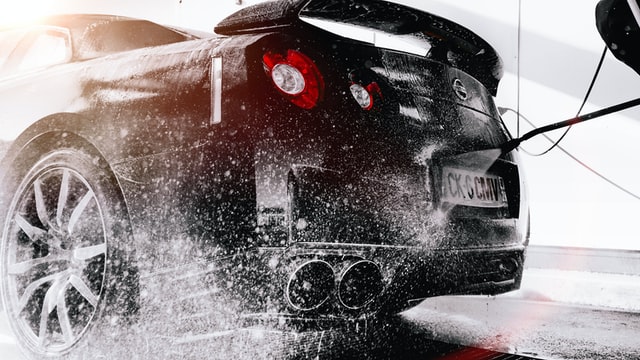When you think of high performance vehicles, which brands first come to mind? Usually, it’s American or European. But it turns out that Japan is also in the supercar game – just without the extortionate prices.
In this post, we take a look at some of the Japanese high-performance cars you’d love to have in your garage. What’s great about the Japanese market is that each carmaker is trying to out-do every other, both in terms of performance and price, leading to some otherworldly results.
Toyota 86

Toyota are best-known for their reliability. But they also have a long history of building high-performance cars to showcase their engineering prowess. The 86 is their latest and, arguably, greatest attempt, showing an entirely new side to the brand. It’s not the quickest car in this list by a long way, having just 200 bhp. But it does provide you with thrills when you roll around corners. Thanks to its communicative chassis, going around a corner at 30 mph feels just as intense as doing it at 60, making this car feel like a supercar, even if it doesn’t accelerate like one.
Nissan 370Z
The Nissan 370Z has always played second-fiddle to the GTR. But it is no less of a masterpiece. The vehicle is quite barebones, meaning that you don’t get many of the safety features you’d find on a non-enthusiast-level car. But that’s not surprising either. This vehicle has been around since 2009 and yet it still looks incredibly up to date.
The 370Z is essentially a classic rear wheel drive coupé. The rear end falls away elegantly, letting you know that this is where the majority of the vehicle’s power comes from. The exhaust is also pretty rasping too, making it a lot of fun to drive.
Toyota Supra

Toyota’s real high-performance car is the Supra. This nifty little car is a world away from it’s 1990s counterpart. Gone is the large sedan chassis, replaced by a vehicle that looks more akin to the Mazda MX-5 (but on steroids).
Some purists will argue that the vehicle isn’t really Japanese since Toyota borrowed so many of the internals from BMW. But it has a great pedigree behind it. And hopefully, thanks to the partnership with BMW, significant reliability as well.
Mazda MX-5
Speaking of the MX-5, it too deserves a spot on this list. This affordable Japanese convertible is one of the company’s most popular vehicles in history, and probably the reason it is still around today.
The MX-5 has everything people want from a sports car. It’s inexpensive, reliable, lightweight and reasonably powerful. What’s more, the new version is significantly more thrilling than the old one, offering a mix of raw performance and comfortable seating.
Many commentators consider this vehicle to be the best value car in the world, period. And, we have no doubt that if you buy it, you’ll agree.
Nissan GT-R

The Nissan GT-R is perhaps the most famous of all Japanese sports cars, thanks to computer games and films featuring it. The vehicle is utterly uncompromising and often outperforms supercars ten times its price.
Its success comes from its ridiculous 0 to 60 speed and incredible grip. The car is able to cover a quarter mile as quickly as a Bugatti Veyron, and it’ll hug the road under G-forces as high as 1.06 – pretty ridiculous.
The only downside of the car? It’s a little old. But Nissan is updating it all the time. After all, why fix something that ain’t broke.
Getting Nissan GT-R performance parts is also relatively easy, even in the US, thanks to the car’s popularity. It’s not a mainstream vehicle by any means, but enough people have them to make the support network pretty good.
Acura NSX
The old Honda NSX was a legendary car. But it has since gone through a significant rebrand under the Acura badge.
The vehicle packs incredible performance, generating a whopping 573 bhp which is nearly double that of the original. And it has a lightweight body which means that it’s capable of blistering acceleration.
Acura says that the NSX is living proof that emotion and technology can coexist. We’re not exactly sure what they mean by that, but what they seem to be getting at is that driving the car is a lot of fun. Just because it has all the latest traction control doesn’t mean that the joy has left the vehicle. It’s all still there.
Subaru WRX STI
Despite the unfortunate name, the Subaru WRX STI is one of the company’s most impressive vehicles to date. It doesn’t have as many of the tech upgrades as some of its rivals. But it is the master of dirt racing, rallies and going off-road – something you can’t really do with the other vehicles on thislist.
The Subaru is refreshingly old school. The turbo has a lag. The engine is a flat four. And you still get a manual six-speed shifter. From the cockpit’s perspective, nothing has changed for a couple of decades. But when you’re driving it, that doesn’t matter. It still feels just as fresh as when Subaru initially released it.
Honda Civic Type R
Honda got into a bit of trouble recently when it stated that it was ditching the manual option for the upcoming 11th-gen Civic. Enthusiasts were appalled and outraged that the brand would abandon its bread and butter and exclusively fit automatic transmission. But later, the company qualified its remarks, confirming that the Type R would still be manual only.
The great thing about the Civic Type R is that it does everything you want it to do. It’s great for track days, but you can also take it to the grocery store. On the outside, the car looks quite sporty, but it’s not over the top. There’s lots of luggage space for practicality, and Honda says that it is going to make a hatchback version for those wanting even more utility.
So, which of these high-performance Japanese cars would you like to see in your garage and why? Let us know in the comments.
Thanks for reading and y’all stay dandy.
-Diego
Follow me on Instagram and Pinterest for more menswear inspiration.
(Some of these links contain affiliate links, so that means if you click and buy something, I get a cut. It helps keep the site going! Full Disclosure)